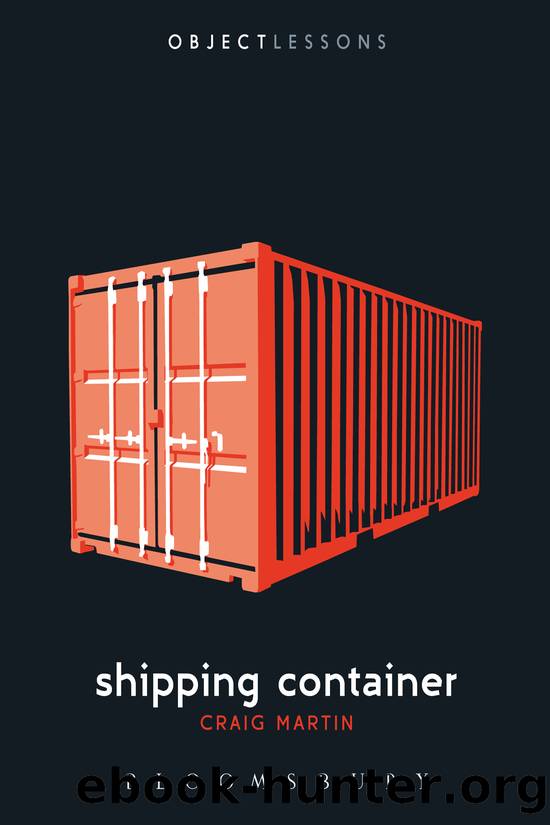Shipping Container by Craig Martin

Author:Craig Martin
Language: eng
Format: epub
Publisher: Bloomsbury
4 BREAKING THE SEAL
It’s a grey, overcast and occasionally wet day. I’m in the passenger seat of a pickup truck at London Thamesport in the south-east of England. Despite its name London Thamesport is a container port situated some distance from any major urban areas, set on the River Medway. You need to drive some 50 miles to get into the heart of London itself. But the port is well connected to the rail and road networks on the outskirts of London, so it has become an important part of the United Kingdom’s container infrastructure. Driving around the port I’m introduced to its various workings, including the dockside operations; the huge stacks of containers where they wait before either being loaded (usually empty) onto waiting container vessels, or more likely, given the flows of trade, offloaded before being picked up by trucks or trains; and the operations control room. The control room is interesting because although it’s at the heart of the port operations it feels a little dishevelled: populated by soft drink cans, old coffee cups and other such remnants of human habitation. I suppose this is inevitable. Such an image stands in contrast to the automated container stacks where a model of efficiency appears to dominate. Given some of the discussions in the previous two chapters, the overall impression that you get from London Thamesport is the choreography of container movements, but this has to be protected – such levels of efficiency need constant maintenance. And I mean this in both senses of the word: through continual repairs to the technical infrastructure, and through its very safeguarding.
The security systems in place here testify to this. Only those truck drivers with the correct documents are granted entry into the port, where the use of encrypted data means that a driver must possess the correct reference number in order to be able to enter the port.1 Once cleared to do so the driver is provided with a pager that identifies both the driver and the container they are there to either collect or offload, or both. This device is used by the driver to enter the main port through a security-gate system, at which point a dedicated printout provides the information about the location in the automated container stacks, where the container is either to be picked up or dropped off. Once this is carried out, for the drivers their allotted role within this port is ostensibly over with and they drive off using the pager to exit the system. On average this takes around thirty to thirty-five minutes. Devices like the pager system produce a secured system within the port that attempts, at least, to develop a structure based on the elimination of ‘uncertainty’, or more prosaically the refusal of entry to those individuals not cleared to enter. A further security feature at London Thamesport is the Customs clearance area. Here containers are weighed to check that their actual weight corresponds to the stated weight on the bills of lading.
Download
This site does not store any files on its server. We only index and link to content provided by other sites. Please contact the content providers to delete copyright contents if any and email us, we'll remove relevant links or contents immediately.
| Books & Reading | Comparative Literature |
| Criticism & Theory | Genres & Styles |
| Movements & Periods | Reference |
| Regional & Cultural | Women Authors |
4 3 2 1: A Novel by Paul Auster(11742)
The handmaid's tale by Margaret Atwood(7407)
Giovanni's Room by James Baldwin(6749)
Asking the Right Questions: A Guide to Critical Thinking by M. Neil Browne & Stuart M. Keeley(5320)
Big Magic: Creative Living Beyond Fear by Elizabeth Gilbert(5303)
Ego Is the Enemy by Ryan Holiday(4891)
On Writing A Memoir of the Craft by Stephen King(4636)
The Body: A Guide for Occupants by Bill Bryson(4539)
Ken Follett - World without end by Ken Follett(4411)
Bluets by Maggie Nelson(4225)
Adulting by Kelly Williams Brown(4197)
Eat That Frog! by Brian Tracy(4101)
Guilty Pleasures by Laurell K Hamilton(4086)
White Noise - A Novel by Don DeLillo(3805)
The Poetry of Pablo Neruda by Pablo Neruda(3781)
Fingerprints of the Gods by Graham Hancock(3707)
Alive: The Story of the Andes Survivors by Piers Paul Read(3703)
The Book of Joy by Dalai Lama(3650)
The Bookshop by Penelope Fitzgerald(3595)
